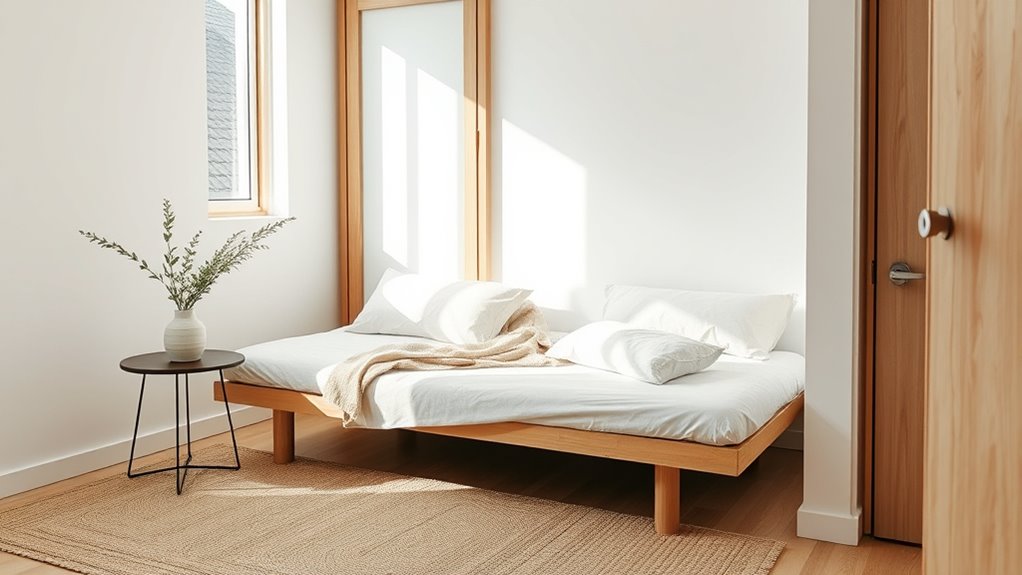Japandi style blends Japanese minimalism with Scandinavian coziness, perfect for small spaces. It emphasizes clean lines, natural materials, and neutral color palettes to create calm, clutter-free environments. Practical furniture like multifunctional pieces and vertical storage helps maximize limited space, while soft lighting and greenery add warmth. To achieve harmony, focus on decluttering, natural textures, and strategic layout choices. If you want to transform your small space into a serene sanctuary, there’s more to explore.
Key Takeaways
- Combines Scandinavian minimalism with Japanese wabi-sabi to create serene, clutter-free small spaces with natural materials and neutral palettes.
- Utilizes space-saving furniture, built-in storage, and strategic layout to maximize functionality and openness in limited areas.
- Enhances natural light with sheer curtains, mirrors, and minimal window treatments to amplify the sense of space.
- Incorporates warm lighting, greenery, and textured textiles to add warmth, depth, and tranquility to compact environments.
- Focuses on decluttering, multifunctional furniture, and vertical storage to maintain harmony and simplicity in small Japandi interiors.
Understanding the Core Principles of Japandi Design
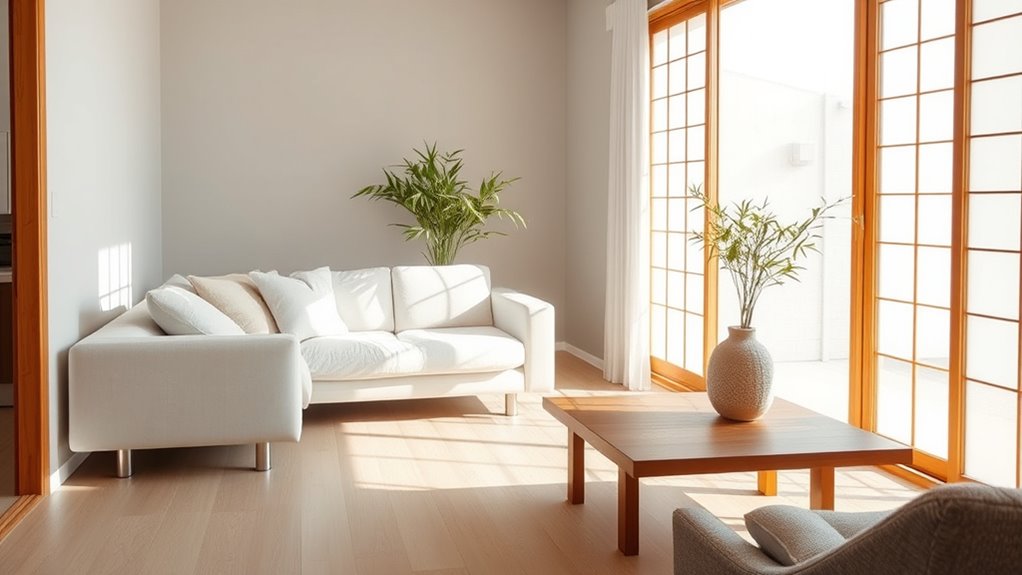
To truly understand Japandi design, you need to grasp its core principles that blend Scandinavian minimalism with Japanese wabi-sabi aesthetics. It emphasizes minimalism, using natural materials like wood and stone to create a serene environment.
Japandi design blends Scandinavian minimalism with Japanese wabi-sabi for a serene, natural, and harmonious space.
A neutral palette dominates, fostering calm and simplicity, while craftsmanship highlights handmade, artisanal pieces over mass-produced items. The style champions clutter-free, open spaces that promote balance and harmony, allowing your surroundings to breathe.
It also values sustainability, choosing eco-friendly materials and practices. The imperfect aesthetic of wabi-sabi celebrates the beauty in imperfection, adding character and authenticity.
Ultimately, Japandi’s principles focus on creating a peaceful, functional space where simplicity, natural elements, and craftsmanship come together to nurture well-being.
Key Elements for Small Spaces in Japandi Style

In small Japandi spaces, choosing neutral color palettes creates an open, calming atmosphere. Natural materials like light wood and stone add warmth without overwhelming the space. Incorporating aesthetic balance helps you focus on selecting harmonious elements that enhance the overall aesthetic. These elements work together to maximize simplicity and serenity, making your area feel larger and more inviting. Additionally, understanding relationship dynamics can help in creating a harmonious environment that promotes peace and well-being. Paying attention to storage solutions ensures that clutter is minimized, further contributing to the tranquil ambiance. Using plants and planters that complement the design style can also enhance the natural, serene vibe while adding a touch of freshness.
Neutral Color Palettes
Neutral color palettes are essential in Japandi style, especially for small spaces, because they create a calm, open atmosphere. Using neutral tones like soft whites, beiges, and light greys helps reflect natural light, making your space feel larger and more inviting. Incorporating cozy textiles such as linen and soft blankets further enhances the sense of comfort and harmony. Earthy colors such as taupe, moss green, and warm browns add warmth and depth without cluttering limited square footage. Incorporating mute accent colors like pastel pinks, blues, or greens introduces subtle character while maintaining tranquility. These palettes foster a serene environment, emphasizing simplicity and harmony. When combined with natural materials like wood and linen, neutral colors enhance the organic aesthetic of Japandi design, making your small space feel balanced, peaceful, and effortlessly stylish. Understanding design principles can help you balance color, texture, and materials to create a cohesive and inviting space. Additionally, choosing appropriate lighting can further enhance the soothing atmosphere characteristic of Japandi interiors.
Natural Material Focus
Natural materials are the foundation of Japandi style, especially in small spaces where every element counts. Using natural materials like wood, linen, and stone helps create a warm, organic atmosphere. To enhance sustainability and style, consider: 1. Incorporating reclaimed or eco-friendly natural materials to support environmental goals and maintain a minimalist look. 2. Mixing textures—smooth wood with textured linen or stone—to add depth without clutter. 3. Choosing high-quality, durable materials that guarantee longevity and timeless appeal. Additionally, selecting affordable and stylish items can help you achieve the desired aesthetic without overspending. Recognizing the importance of personality traits can also influence how you select and arrange decor to create a harmonious environment. Incorporating self-watering plant pots made from natural materials can also support your sustainable design goals and keep your plants healthy. For instance, using natural textiles like linen or cotton for cushions and curtains complements the organic vibe while providing comfort. These elements emphasize sustainability, durability, and organic beauty, making your small space feel serene and balanced.
Color Palette and Texture Choices for Compact Living Areas
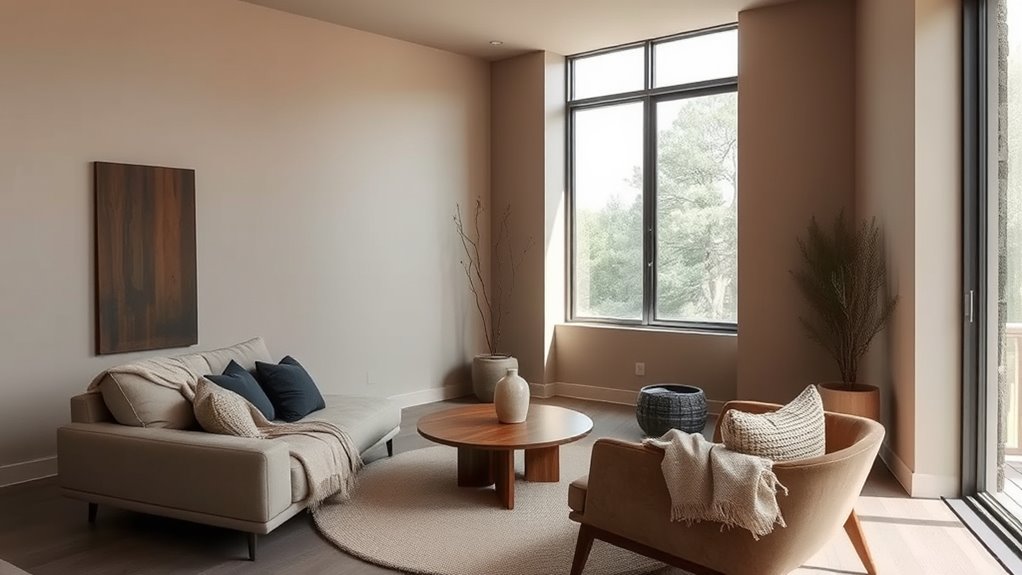
To create a serene and inviting Japandi-inspired space in a compact area, choosing the right color palette and textures is essential. Focus on neutral tones like beige, soft white, and light gray to establish a calming, minimalist aesthetic.
Incorporate natural materials such as wood, linen, and ceramics to add tactile warmth and tactile contrast. Earthy accents like moss green and terracotta introduce subtle contrast and depth without overwhelming small spaces. Emphasizing mindful design principles can help optimize small areas for both beauty and functionality.
Muted pastels, like baby blue or Slipper Pink, provide gentle character while maintaining understated elegance. Layering textures—smooth wood with textured textiles—enhances visual interest and depth, making your space feel cozy yet uncluttered. Considering crisp, safe sleep environments can also influence the overall calming atmosphere of your home.
Additionally, incorporating interior antiques thoughtfully can add a unique focal point and charm, enriching the overall aesthetic without crowding the limited space. Being mindful of appliance maintenance plans ensures your appliances remain efficient and reliable, contributing to a well-functioning small home.
Furniture Selection and Layout Optimization
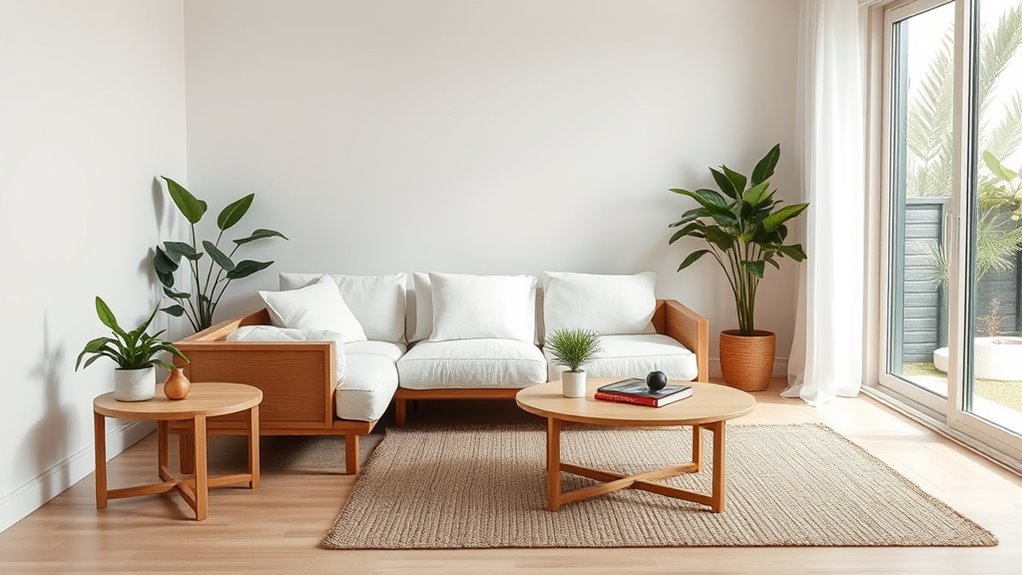
To create a balanced Japandi space, focus on selecting low-profile, streamlined furniture with clean lines that make your rooms feel open. Incorporate multifunctional pieces like storage ottomans and extendable tables to maximize utility without clutter. Arrange your furniture thoughtfully, placing larger items against walls and using mirrors to reflect light and enhance the sense of space. Additionally, choosing vetted and well-constructed pieces ensures durability and comfort in your small space.
Low-Profile, Minimalist Furniture
Low-profile, minimalist furniture is essential in Japandi design because it helps create a sense of openness and tranquility in small spaces. By choosing pieces with clean lines and unobtrusive profiles, you enhance the airy feel and make your room appear larger. Focus on natural wood finishes that add warmth without bulk.
Incorporate multifunctional pieces, such as sofas with built-in storage or tables with hidden compartments, to maximize utility. To optimize space, consider:
- Placing furniture away from walkways for better flow
- Using storage solutions that blend seamlessly with the design
- Selecting compact layouts with scaled-down furniture to maintain a balanced, uncluttered environment
These strategies ensure your space feels both functional and serene, embodying the minimalist aesthetic of Japandi style.
Multifunctional Space Savers
In Japandi design, choosing multifunctional furniture and optimizing layout are key to maximizing space while maintaining its minimalist aesthetic. You’ll want versatile furniture like sofas that convert into beds and tables with built-in storage to enhance small space optimization. Streamlined furniture with clean lines helps create an open floor plan and a clutter-free environment. Incorporate wall-mounted solutions and built-in shelving to add storage without sacrificing style, reducing visual clutter. Focus on a minimalist layout by placing furniture thoughtfully, away from walkways, to improve flow. Using furniture with hidden compartments or drawers maximizes functionality while keeping the space sleek. Additionally, selecting compact, portable furniture that can be easily moved or reconfigured allows for adaptable living arrangements and further enhances space efficiency. A multi-use approach to furniture design encourages resourcefulness and flexibility in small living areas. Emphasizing space-saving strategies such as dual-purpose pieces can significantly improve the functionality of small spaces by serving dual roles without crowding the area. Incorporating outdoor elements like small balconies or indoor plants can also expand the sense of space and bring a calming influence into the home. These space-saving design strategies ensure your small space feels expansive, cohesive, and effortlessly functional, perfectly blending form and function in your Japandi-inspired home.
Strategic Placement Techniques
Strategic placement of furniture plays an essential role in maximizing space and enhancing the flow of your Japandi-inspired home. To achieve this, focus on:
- Using minimalist furniture with low-profile design and clean lines to keep the space open. Additionally, choosing pieces that are durable and easy to maintain can help sustain the aesthetic over time. Integrating rustic elements such as natural wood accents can also add warmth and texture to the minimalist decor.
- Incorporating multifunctional pieces like beds with built-in storage and foldable tables for space optimization.
- Arranging furniture away from walkways and windows to improve flow and natural lighting, while adding mirrors to reflect light and create the illusion of more space. Moreover, understanding cybersecurity principles, such as data protection, can be beneficial when managing smart home devices to ensure your space remains secure.
Additionally, utilize vertical storage with wall-mounted shelves and hidden compartments to keep surfaces decluttered.
An open layout combined with thoughtful placement ensures effortless movement and a serene, spacious environment that embodies Japandi’s balance of simplicity and functionality. Incorporating tableware into your home decor can also enhance the aesthetic and functionality of your living space.
Lighting Techniques to Enhance Space and Atmosphere
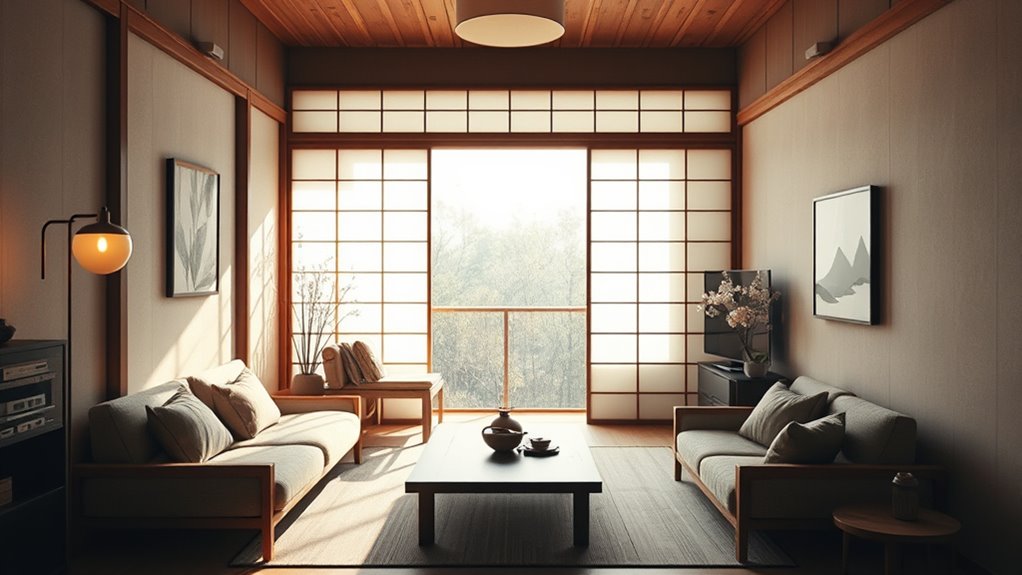
Maximizing natural light is essential in Japandi interiors, as it makes spaces feel larger and more open. Use sheer curtains or blinds that allow sunlight to flood your rooms, enhancing the sense of space.
Incorporate layered lighting techniques by combining ambient lighting with diffused artificial lighting, such as wall-mounted or pendant lights, to create a warm, calming atmosphere. Choose warm-toned bulbs and lighting accessories like candles or lanterns to add coziness.
Strategically position lighting fixtures to reduce shadows and clutter, highlighting natural materials and clean lines characteristic of Japandi design. This approach not only enhances space but also promotes a tranquil environment, making your small space feel inviting and thoughtfully curated.
Creative Storage Solutions and Decorative Techniques
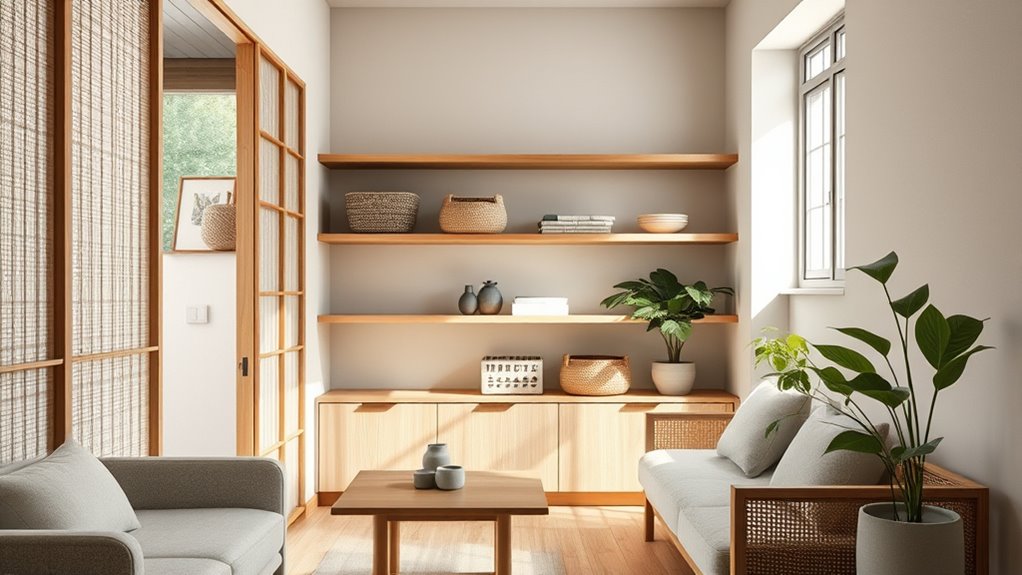
To keep your Japandi space feeling calm and uncluttered, incorporate creative storage solutions that blend seamlessly with the minimalist aesthetic. Use hidden storage like beds with built-in drawers, ottomans with compartments, or wall-mounted cabinets to maintain a clean look.
Create a calm, clutter-free Japandi space with hidden storage and sleek, natural solutions.
Embrace multifunctional furniture, such as extendable tables and sofa beds, to maximize space and reduce unnecessary decor.
Opt for minimalist storage made of natural materials—bamboo baskets or wooden shelves—that complement Japandi’s natural vibe.
Implement smart organization with open shelving paired with decorative baskets or boxes to balance function and style.
Finally, utilize vertical space through wall-mounted storage or hanging planters to enhance space optimization, ensuring your Japandi interior remains serene and clutter-free.
Practical Tips to Achieve a Harmonious Japandi Look in Limited Spaces
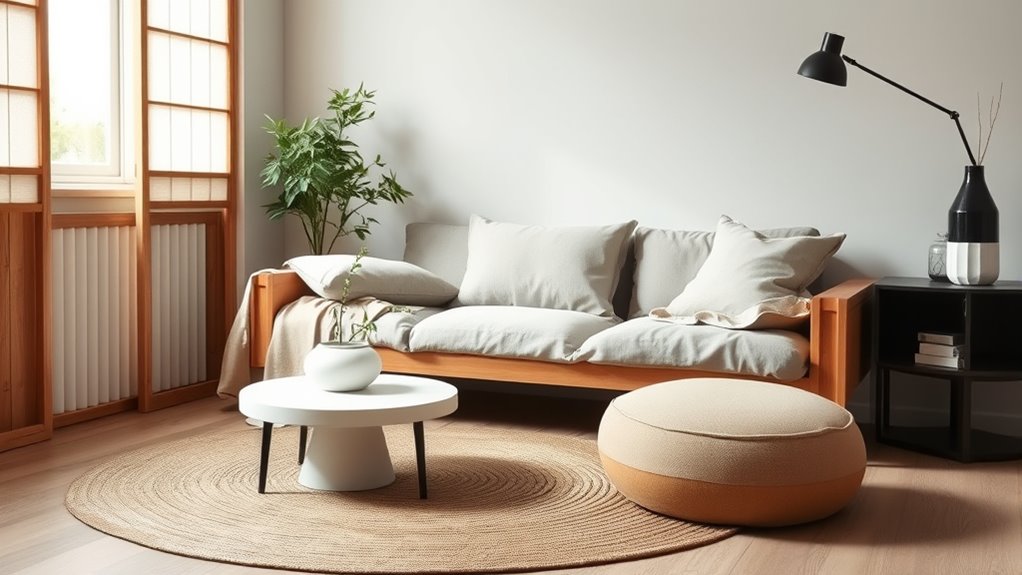
Achieving a harmonious Japandi look in limited spaces requires thoughtful organization and smart furniture choices. Focus on decluttering and use multifunctional furniture to maximize space efficiency without sacrificing minimalism. Stick to a neutral color palette with light tones and natural materials like wood and linen, which make small areas feel open and inviting. Incorporate vertical storage solutions, such as wall-mounted shelves and built-in cabinets, to reduce surface clutter and optimize floor space. Enhance natural light with sheer curtains and strategically placed mirrors to create a brighter, more expansive environment. Add greenery and subtle textures through plants and textiles to introduce warmth and depth without overcrowding.
| Decluttering | Multifunctional Furniture | Vertical Storage |
|---|---|---|
| Clear surfaces | Dual-purpose pieces | Wall-mounted shelves |
| Simplify decor | Space-saving furniture | Built-in cabinets |
| Minimize accessories | Compact design | Overhead storage |
Frequently Asked Questions
How Can I Incorporate Natural Materials Without Cluttering My Small Space?
You want to incorporate natural materials without cluttering your small space. Focus on choosing a few key pieces like a wooden coffee table or wicker baskets to add warmth and texture.
Keep your decor minimal and let these natural elements stand out. Use open shelving to display your items neatly, avoiding excess.
What Are Some Budget-Friendly Ways to Achieve a Japandi Aesthetic?
You might think achieving a stylish look costs a fortune, but it doesn’t have to. Start with simple, affordable pieces like neutral-toned textiles, minimalist furniture, and natural accessories.
Repurpose items you already own or shop secondhand for unique finds. Focus on clean lines, uncluttered spaces, and cozy textures to create a serene atmosphere.
With a little effort, you can easily transform your space into a calming, elegant haven without breaking the bank.
How Do I Balance Dark Accents With Light Tones in Small Rooms?
To balance dark accents with light tones in small rooms, start by using dark hues sparingly on key pieces like a sofa or accent wall. Keep walls and larger furniture in light shades to open up the space.
Incorporate dark accessories, such as cushions or vases, to add contrast without overwhelming. Use natural light and minimalist decor to maintain an airy, balanced feel that highlights both your dark accents and light tones effectively.
What Are Common Mistakes to Avoid When Designing Japandi in Limited Space?
When designing in limited space, don’t forget to dodge the common mistakes that can clutter your calm. You might overdo the decor, sacrificing simplicity, or ignore the importance of natural light, making the room feel cramped.
Avoid overcrowding with furniture, which hampers flow, and neglect cohesive color schemes that can clash and create chaos.
Instead, prioritize minimalism, maximize natural light, and maintain harmonious hues to keep your space serene and stylish.
How Can I Personalize a Japandi-Inspired Interior Without Losing Minimalism?
You can personalize a minimalistic space by adding meaningful accessories like a handcrafted vase or a favorite artwork, but keep it simple to maintain the clean aesthetic.
Incorporate subtle textures through textiles or natural materials to reflect your personality.
Use a few well-chosen plants for a touch of nature.
Conclusion
So, you’ve mastered Japandi in your tiny space—who knew minimalism could be so cozy? Just remember, the secret isn’t in the clutter or the size, but in your eye for balance and serenity. Ironically, achieving that perfect blend of Japanese simplicity and Scandinavian warmth might require a little chaos—carefully curated chaos, of course. Now, sit back, breathe in, and enjoy your beautifully clutter-free, yet comfortably lived-in, Japandi sanctuary.
